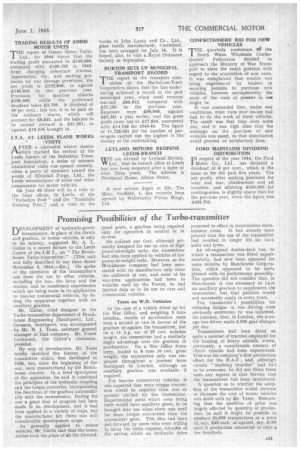Promising Possibilities of the Turbo-transmitter
Page 23

If you've noticed an error in this article please click here to report it so we can fix it.
DEVELOPMENT of hydraulic-power transmission, in place of the clutch and gearbox, in motor vehicles, is only in its infancy, suggested Mr. A. L. Gatiss in a recent lecture to the Leeds Centre of the I.M.T., on "The Brockhouse Turbo-transmitter." [This unit was fully described in our issue dated November 3, 1944.—En.] He spoke of the extension of the transmitter's use from the car to other vehicles, including the bus, the lorry and the tractor, and he mentioned experiments which are being made in its application to heavier commercial vehicles, by fitting the apparatus together with an auxiliary gearbox.
Mr. G'atiss, chief designer in the Turbo-transmitter department of Brockhouse Engineering (Southport), Ltd., Crossens, Southport, was accompanied by Mr. B. J. Tams, assistant general manager of that company. Mr. Frank Lockwood, the Centre's chairman, presided.
By way of introduction, Mr. Tams briefly sketched the history of the transmitter which, first developed in 1936, has, since the beginning of the war, been manufactured by the Brockhouse concern. In a brief cipscription of the apparatus, he said it combined the principles of the hydraulic coupling and the torque converter., incorporating the functiOns of the-gearbox automatically With the transmission, During the war a great deal of progress had been made in its development, and it had been applied in a variety of ways, but the manufacturer felt there was still considerable development scope.
As generally applied to motor vehicles, Mr. Gatiss said that the transmitter took the place of all the forward
speed gears, a gearbox being required Only foroperation in neutral or in reverse.
He pointed out that, although primarily designed for use on cars of high power-to-weight ratio, the transmitter had also been applied to vehicles of low power-to-weight ratio. However, as the Brockhouse company had been associated with its manufacture only since the outbreak of war, and most of its war-time applications had been to vehicles used by the Forces, he had limited data as to its use on cars and commercial vehicles.
Tests on W.D. Vehicles
In the case of a Vehicle fitted up for the War. Office, and weighing 3 tons unladen, results of acceleration tests were a second or two in favour of the gearbox as against the transmitter, but on a 14 h.p. car of '27 cwt. unladen weight, the transmitter bad a similarly slight advantage over the gearbox in acceleration. On a War Office 3-ton lorry, loaded to 8 tons 10 cwt. gross weight, the transmitter only was employed throughout a journey from Southport to London, although an auxiliary gearbox was available if required.
For heavier commercial vehicles, it Was expected that more torque conversion would be required than was at present yielded by the transmitter. Experimental units which were being built would have auxiliary gears, to be brought into use when there was need for more torque conversion than the transmitter, gave. This idea had been put-forward by users who were wining to incur the extra expense,-becaulte of the saving which an hydraulic drive promised to effect in transmission maintenance costs. It had already been proved that the use of the transmitter had resulted in longer life for back axles and tyres.
An oil-engined double-deck bus, to which a transmitter was fitted experimentally, had now been operated for some months by Manchester Corperation, which appeared to be quite pleased with its performance generally. The operator did not consider that, in -Manchester, it was necessary to have an auxiliary gearbox to supplement the transmitter, but that position would not necessarily apply in every town.
The transmitter's possibilities for reducing fatigue in bus driving were obviously enormouss he was informed, for instance, that, in London, the average bus driver made 3,000 gear, changes per day.
Transmitters had been fitted to quite a number of tractors employed for the hauling of heavy aircraft, where, previously, a considerable amount of clutch trouble had been experienced. This was his company's first production effort for the R.A_F., and, although certain " teething troubles" had had to be overcome, he did not think there were any regrets in that Service that the transmitters had been introduced.
A question as to whether the adoption of the transmitter would increase or decrease the cost of motor vehicles was dealt with by Mr. Tams. Remarking that the question of price was largely affected by quantity of production, he said it might be possible to produce 50,000 transmitters at a price of, say, £40 each, as against, say, £100 each.if production amounted to only a few hundreds.




















































